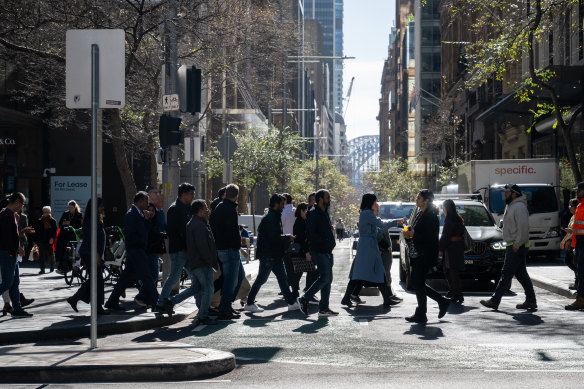
Some supply shocks could even wreak longer-term or permanent damage on how much we’re capable of producing. Energy prices, for example, have stayed well above pre-pandemic levels in a handful of countries.
At the same time, we’re facing longer-term supply speed bumps such as a fall in the working age population as more of us age and have fewer kids, and slowing globalisation. This means we have fewer workers, and we’re less able to just rely on trade and migration to make up for when we have a shortage of something, whether that be workers, particular materials or machines – making us a lot less agile than we once were.
If there’s one thing we’ve learned from the post-pandemic inflation surge, Maechler says it’s that “forceful monetary policy tightening has been necessary to re-anchor inflation at low and stable levels”. Basically, high-interest rates are important whenever inflation looks like it’s taking off, to rein in business and consumer expectations.
Otherwise, expectations for ever-higher inflation can end up feeding the beast of inflation itself, as consumers and businesses look to spend more now (increasing demand) in the hopes of beating future price rises. A shock – whether demand or supply side – is especially influential on expectations, and important to factor in when, as we’ve experienced in the past few years, inflation is already running high.
But what about the effects of higher interest rates on unemployment? Well, Maechler says the trade-off between inflation and unemployment might not be the same as it once was.
Whether interest rates have “smashed” Australia’s economic growth or not, there’s one thing few dispute: our jobs market (despite showing signs of wear) has held up remarkably well. In fact, it’s going so well that if Kiwi economist Bill Phillips was still around, he might, for a moment, wonder whether his famous theory needs a revamp.
The “Phillips curve”, introduced in 1958, suggests that as inflation falls, unemployment tends to rise. Or, put the other way, as unemployment falls, inflation tends to rise. Basically, Phillips developed the idea that the more people we have in jobs, the more we’ll see prices rise. Why? Because when more people are working, there’s less “slack” or availability in the economy.

So far, despite inflation being dragged back down towards the 2 to 3 per cent target, unemployment remains steady.Credit: Louie Douvis
Businesses then have to compete for a smaller pool of available workers. That means, in theory, those firms have to pay more to attract and keep their workers (who also have more power to demand higher wages). Unless those businesses generously decide to stomach the higher bills themselves by giving up some of their profit, the extra cost is passed on to customers through higher prices.
The Reserve Bank has been trying to toe the fine line between getting inflation down and limiting the number of job losses. So far, despite inflation being dragged back down towards the 2 to 3 per cent target, unemployment has remained pretty steady. How is this possible?
Loading
Well, Maechler says it’s because the Phillips curve is steeper under certain conditions. Instead of an exactly proportionate trade-off between inflation and unemployment, the post-COVID burst of inflation has shown inflation can come down with a proportionately smaller rise in unemployment. As much as an increase in interest rates hurts a lot of people, it might not be as bad when lots of people are employed and the economy is adding jobs.
Of course, the RBA still has to walk a fine line. A demand or supply shock when the labour market is already tight tends to translate a lot more sharply into inflationary pressure. But keeping interest rates too high for too long can plunge the economy into recession and kick our extraordinary job market gains to the curb.
The best way to guard against the inflation problem, which continues to threaten us from both the demand and supply side, is to build the capacity of our economy – and make it more flexible.
That will require an open global economy and turbocharging our productivity. If we do that, central banks might not have to tighten their grips so much, even when they’re supplied a shock.
The Business Briefing newsletter delivers major stories, exclusive coverage and expert opinion. Sign up to get it every weekday morning.



























